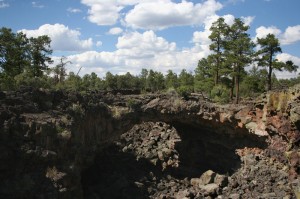Building bridges

The camera aboard NASA’s Lunar Reconnaissance Orbiter spacecraft, currently about to begin its second year of mapping the Moon, continues to reveal new and fascinating details of the geology of the Moon. A recent featured image at the LROC web site shows what appears to be a “natural bridge” on the lunar surface, i.e., an unsupported strip of terrain that connects two topographic prominences. What might this feature be telling us about the Moon’s processes and history?
Natural bridges are not common on Earth. They typically form by erosion of rock from beneath, in which material is slowly and gradually removed at such a rate that the uppermost surface remains intact. They are found most often on Earth in sedimentary deposits, in which running water erodes rock away from opposite sides of an area, causing the retreat of two scarps that eventually meet, leaving an intact arch or “bridge” that appears to connect two hills. Such a feature is ephemeral, of course; the same erosion that created the bridge will eventually destroy it, leaving at last only two disconnected hills, both of which will eventually be eroded flat themselves over time.
As there is no running water, how can such a feature be made on the Moon? A flowing liquid is involved, but it’s not water. I have discussed the flow of lava in the lunar maria and its production of caves in a previous column. Billions of years ago, lava erupted onto the surface of the Moon. This lava was of very low viscosity (about the consistency of motor oil at room temperature) and it spread out into thin sheets that flowed across the surface very rapidly. As the lava cooled, it solidified from the outside inward, leaving the hottest, most fluid material in the center of the flow. In some cases, this created a lava tube, which is a very efficient method of transporting erupted lava from a vent to a flow margin. Lava tubes can be active for most of the duration of an eruption and when the eruption stops, the lava inside them often drains out, leaving behind an empty, underground tunnel. Sometimes, the roofs of these tunnels collapse, exposing the tube interiors to space through cave “skylights.”
It is difficult to understand how caves on the Moon may be preserved for very long periods of time. When drained, the tube roofs are exposed to space and over time, may be hit by impact debris, both meteoroid projectiles from space and secondary debris kicked up by other impacts nearby. This debris will erode and shake the surface and could destroy the tube roofs to the point where they might collapse, filling in the underlying void space. If such a process were incomplete, collapse could create a natural bridge on the Moon, where adjacent segments of a collapsed lava tube roof are still connected by a segment of the roof that has not yet been destroyed (see picture above).
One interesting aspect of the newly found natural bridge is that it does not occur in volcanic terrain, but in the middle of the far side highlands. How can such a feature form here, so far away from the volcanic maria that is found predominantly on the near side? The same processes are at work but the liquid rock here has a different origin. During very large impact events, some of the shock energy of the impacting projectile is dissipated as heat, both vaporizing and melting some of the rocky target. The LROC images have shown us a wealth of features around very young craters that appear to be solidified flows of liquid rock (shock melt from the impact event). In the case of this natural bridge, it is found in a smooth pool of impact melt that was formed when the 70 km diameter crater King was formed. King is a very young crater in lunar terms, probably having formed no more than a few hundred million years ago. This is extremely old by Earth standards, but on the Moon – with its extremely low rates of erosion – it is part of the Copernican time system, which encompasses events that occurred within the last one billion years of lunar history. King is probably slightly younger than the crater Copernicus and to look at its rim in the high resolution images from LROC, one sees a myriad of fresh, crisp features that look liked they formed only a few days ago.
The natural bridge found near King crater probably formed when a large pool of shock liquid rock cooled enough to roof over, creating a solid surface crust. Downhill draining of the melt pond removed the liquid from beneath this crust, weakening the surface and causing its collapse in some places. The natural bridge is actually just a zone of preserved surface crust that occurs between two adjacent collapse pits. As with natural bridges on the Earth, this bridge is transient; the constant bombardment of the lunar surface will grind away the bridge through erosion by impact, which is extremely slow (erosion rates on the order of one millimeter per 20 million years.) Eventually, both surface grinding and shaking during impacts will cause the collapse of this feature. However, this won’t happen anytime soon, so you have several tens of millions of years to see it.
/https://tf-cmsv2-smithsonianmag-media.s3.amazonaws.com/accounts/headshot/blog_headshot_spudis-300x300.jpg)
/https://tf-cmsv2-smithsonianmag-media.s3.amazonaws.com/accounts/headshot/blog_headshot_spudis-300x300.jpg)